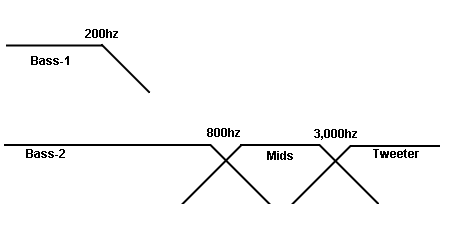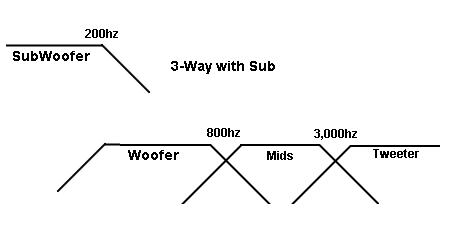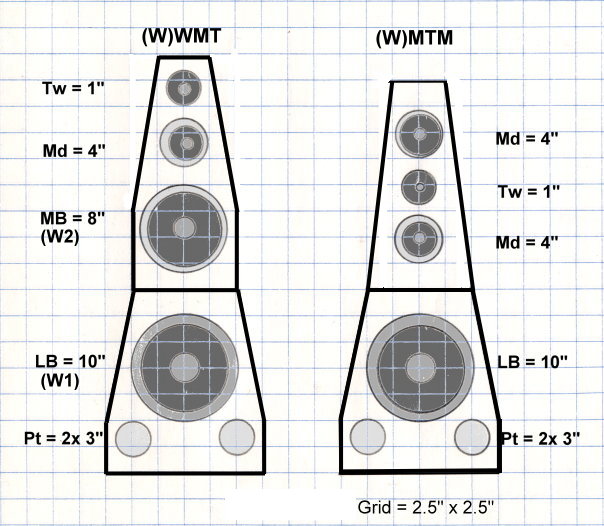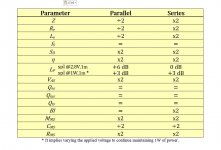Your math is wrong. Addition of two random noise signals is +3dB in power, but here we have two signals in phase, so it is +6dB:
perhaps you should reread my answer.
When 2 sounds are in phase, the pressures add together.
That means +3dB if the signals are identical, 0dB for random noise to each.
thanks, but what myhrrhleine said is what i understand before this thread is started
you guys are saying the complete opposite if i read correctly, so who is correct?
ok its 6dB gain as evidenced by some measurement data
not just sensitivity but also efficiency which is good
will measure myself just to see how close i will get
thanks all!
not just sensitivity but also efficiency which is good
will measure myself just to see how close i will get
thanks all!
Sorry for late reply.
Me a more practical guy than a technical guy.
So excuse for simple explaination.
This is my experiment.
I took a tall half inch plywood sheet 18" wide.
Made 4 of 8" holes in a row in the center line.
This made an open baffle. Made a matching pair.
I have many pairs of 8" woofers of different types.
Took one of each and tested individually in the holes to find
What type performed well in the open baffle.
What I found out was the ones with very stiff cone movement performed well in the open baffle.
This is because the open baffle did not provide any resistance to the cone movement like a sealed box or a ported box did. So even some woofers rated at 100 watts bottomed at say 10 watts in the open baffle.
In comparision the Fostex 206E which has a soft cone movement bottemed hopelessly at 5 watts in the open baffle.
This is where the Qts of the driver comes in. The Fostex 206E
With a very low Qts of 0.18 is only ment for horns. Where as drivers with Qts of greater than 0.6 performed well in open baffles.
Lets go back to our topic.
The sole purpose of my experiment was to find out a speaker combination to equal or exceed the sensity of the Fostex 206E which is 106 dB/w.
By my testing done on drivers I found four pairs which matched closly and performed well in the open baffle.
These were of low sensitivity rangeof 93 dB. All near 100 watts and 8 ohms.
Confirmed by testing them on a closed box with 1 watt power giving very little sound where the high sensitive Fostex was loud on the same conditions.
I installed the selected set of 4 woofers in series parallel combination to give 8 ohm impedance in each open baffle.
Upon testing I had to add 4" side pannels at the back of the plyboard to increase the bass upto my taste.
Made a pair of open baffles using 4 pairs of drivers matching them cymetrically in both baffles.
The resulting sound was unbelieveably loud.
Louder than the 106 dB Fostex.
Although each driver was rated 100 watts each, the combined 4 drivers in the open baffle bottomed at about 15 watts volume level. At this level it was impossible to be in the room as it was too loud and uncomfortable.
To compare one open baffle was tied to the left channel of my 2a3 se tube amp which had 3.5 watts of power each.
On the right was the 206E placed in a tall transmission line cabinet to bring up the bass (to tame its midrange shout)The
Open baffle was louder than the 106 dB Fostex in the trabsmission line. That is 4 drivers of 93 dB in series parallel had A combined sensitivity of more than 106 dB.
Result ?
Guys, even as I type I dream of the sound.
I have built and herd horns.
I have listened to transmission lines.
My Yamaha NS 10,000 is supposed to be one of the best sounding sealed box speakers.
But the sound you get from the open baffles is the closest to the sound you hear at the concert halls live performance.
Every thing else is so artificial. A clever listner will be able to identify the sound comming out of other types of speakers.
The finel test was done in the night with all lights off in total darkness.The sound was so gostly (too real) I got goose pimples.
Other than the sound the experoment revealed thtat the sound increased four fould because the driver cone area has increased four fold.( ie. not doubled but quadrapled).
Plese excuse me as I have to go Back to my listening.
I found an old CD, which now, I am certain will contain new music ?
Me a more practical guy than a technical guy.
So excuse for simple explaination.
This is my experiment.
I took a tall half inch plywood sheet 18" wide.
Made 4 of 8" holes in a row in the center line.
This made an open baffle. Made a matching pair.
I have many pairs of 8" woofers of different types.
Took one of each and tested individually in the holes to find
What type performed well in the open baffle.
What I found out was the ones with very stiff cone movement performed well in the open baffle.
This is because the open baffle did not provide any resistance to the cone movement like a sealed box or a ported box did. So even some woofers rated at 100 watts bottomed at say 10 watts in the open baffle.
In comparision the Fostex 206E which has a soft cone movement bottemed hopelessly at 5 watts in the open baffle.
This is where the Qts of the driver comes in. The Fostex 206E
With a very low Qts of 0.18 is only ment for horns. Where as drivers with Qts of greater than 0.6 performed well in open baffles.
Lets go back to our topic.
The sole purpose of my experiment was to find out a speaker combination to equal or exceed the sensity of the Fostex 206E which is 106 dB/w.
By my testing done on drivers I found four pairs which matched closly and performed well in the open baffle.
These were of low sensitivity rangeof 93 dB. All near 100 watts and 8 ohms.
Confirmed by testing them on a closed box with 1 watt power giving very little sound where the high sensitive Fostex was loud on the same conditions.
I installed the selected set of 4 woofers in series parallel combination to give 8 ohm impedance in each open baffle.
Upon testing I had to add 4" side pannels at the back of the plyboard to increase the bass upto my taste.
Made a pair of open baffles using 4 pairs of drivers matching them cymetrically in both baffles.
The resulting sound was unbelieveably loud.
Louder than the 106 dB Fostex.
Although each driver was rated 100 watts each, the combined 4 drivers in the open baffle bottomed at about 15 watts volume level. At this level it was impossible to be in the room as it was too loud and uncomfortable.
To compare one open baffle was tied to the left channel of my 2a3 se tube amp which had 3.5 watts of power each.
On the right was the 206E placed in a tall transmission line cabinet to bring up the bass (to tame its midrange shout)The
Open baffle was louder than the 106 dB Fostex in the trabsmission line. That is 4 drivers of 93 dB in series parallel had A combined sensitivity of more than 106 dB.
Result ?
Guys, even as I type I dream of the sound.
I have built and herd horns.
I have listened to transmission lines.
My Yamaha NS 10,000 is supposed to be one of the best sounding sealed box speakers.
But the sound you get from the open baffles is the closest to the sound you hear at the concert halls live performance.
Every thing else is so artificial. A clever listner will be able to identify the sound comming out of other types of speakers.
The finel test was done in the night with all lights off in total darkness.The sound was so gostly (too real) I got goose pimples.
Other than the sound the experoment revealed thtat the sound increased four fould because the driver cone area has increased four fold.( ie. not doubled but quadrapled).
Plese excuse me as I have to go Back to my listening.
I found an old CD, which now, I am certain will contain new music ?
wow thanks srian!!!
i must build one some day!!!
i reckon the better sound is due to that each driver only need to operate at -12dB to obtain the same spl, so i guess the distortion will also decrease by 12dB, which is tremendous!!!
i must build one some day!!!
i reckon the better sound is due to that each driver only need to operate at -12dB to obtain the same spl, so i guess the distortion will also decrease by 12dB, which is tremendous!!!
Right on Steve, you were the first to get it right,,, at least with an understandable explanation. There was looking to be a fee lunch there for a while with 6db up in parallel, and 3db up when wired in series.Did anyone notice that this thread was STARTED in 2008?
The above suggestion is in error. In Parallel, both speakers get the same voltage and have the same output, but combining them should give you a roughly +3db boost.
However, in Series, each speaker gets HALF the voltage, you get more output because of two speakers, but with each getting half the voltage, the output drops back. So it is +3 -3 = 0db. The output for two speakers is the same as the output for one speaker (more or less).
However, each speaker will consume half the power and have half the excursion. Typically given a boost in sound quality and low distortion.
Right on Steve, your the first to get it right on,,,, at least in an understandable way.
If we assume this is ultimately a 3-way with a Midrange, then there are two ways to do this.
1.) At the lowest of the low frequencies, both bass drivers run in parallel. That would be a 3.5-way system.

2.) Build the equivalent of a 4-way system - Low-Bass, Mid-Bass, Midrange, tweeter.

I've considered doing something similar with a 10" and a 8". Using not the same size drivers is unconventional, but it can be done.

Now, I used 3-way and 4-way in my examples because I already had those graphics. The absents or presents of a Midrange is up to you.
Though I think the 60hz and 200hz crossovers are bit unrealistic. Though what the precises crossover would be would depend on the rest of your design.
In a 3-way, the Low-Bass crossover could be in the 100hz to 300hz range, and the Mid-Bass to Midrange crossover would likely be in the 500hz to 1000hz range, though 500hz and 800hz are common in a 3-way.
With a Parallel configuration you get more output but at the cost of lower impedance and higher current. Higher current means more heat in the amp.
In Series you get greater power handling, but less output.
Also, in a multi-way system, where each driver has its own individual selected range of frequencies, their impedance does not combine.
As an example, if the Low-Bass covers 0hz to 200hz, and the Mid-Bass covers 200hz to 800hz, those impedance are not combined. Each has the impedance of a single speaker in their Pass-Band.
In a 2.5-way or a 3.5-way the Low-Bass would cover, just as an example, 0hz to 200hz, and the Mid-Bass would cover 0hz to 800hz. So, both are in parallel between 0hz and 200hz with a combined parallel impedance of 4 ohms. Above 200hz, the speaker system would be 8 ohms.
So, to make any sense of this, we would not only need to know about the woofer, but the vision for the complete system.
Does he plan to overlap the speakers, or does he plan to give each bass driver its own personal frequency range to deal with?
The OP is saying that the speakers will be in Parallel or Series, that implies that they can only cover the same frequency range. That's not really good design.
So, if the Original Poster is still around, he would need to give us his overall vision for the full speakers system. Then we can evaluate the possibilities. But without that, he will get nothing but speculation about what we think his vision of the speaker system might be.
But to his basic question, 2 speakers in Parallel will have higher output but lower impedance. Two speakers in Series, will have the output of one speaker, but each speaker will have half the voltage and half the excursion boosting power handling and lowering distortion.
That said, as he stated it, I don't think this is a realistic design. Perhaps he has no design and was simply wondering about the possibility of combining two speakers, but my interpretation of what he described is unrealistic in a real speaker design.
Just a few thoughts.
Steve/bluewizard
3 drivers paralell
Hi!
What about with this combination: 3 similar drivers, but with different impedance in paralell. 16+16+8 ohm. All has 93 dB sensitivity.
What will be the summed sensitivity?
Greets:
Tyimo
Hi!
What about with this combination: 3 similar drivers, but with different impedance in paralell. 16+16+8 ohm. All has 93 dB sensitivity.
What will be the summed sensitivity?
Greets:
Tyimo
Hi!
What about with this combination: 3 similar drivers, but with different impedance in paralell. 16+16+8 ohm. All has 93 dB sensitivity.
What will be the summed sensitivity?
For an accurate answer it must be known whether the sensitivity specifications are measured as 1 watt into the specified impedance, or measured at 2.83V input (equivalent to 1watt @ 8Ω). Both measurements are frequently used and often not referenced.
Assuming all of the drivers are in parallel, they all get the same voltage. At 2.83V the 8Ω driver receive 1 watt and will produce 93dB, but the two 16Ω drivers will receive only ½watt each and produce 90dB each. (By definition a halving of power -3dB, a doubling +3dB.) To get 1 watt into each of the 16Ω drivers you'll need 4.00 volts.
Adding the two 16Ω drivers is doubling the power, so the two together will give 93dB. Now adding the 8Ω driver doubles the power again and gives an additional 3dB, totalling 96dB/2.83V/1m for the three drivers together. The reality will be slightly different because the polar response of three drivers will contract compared to a single driver, and on axis the SPL will go up slightly. The total power delivered into the room will not change, or else the conservation of power law would be broken, so the off axis SPL will drop slightly.
Adding the two 16Ω drivers is doubling the power, so the two together will give 93dB. Now adding the 8Ω driver doubles the power again and gives an additional 3dB, totalling 96dB/2.83V/1m for the three drivers together. The reality will be slightly different because the polar response of three drivers will contract compared to a single driver, and on axis the SPL will go up slightly. The total power delivered into the room will not change, or else the conservation of power law would be broken, so the off axis SPL will drop slightly.
If the 16Ω drivers produce 93dB from 2.83V, then you have three drivers that produce 93dB each. This is a bit tricker to calculate. You can add their powers, but first you must start from a linear equation, not a log one which decibels are. To express x3 in dB we use the formula (for power) 10 x (log10 R), where R is the ratio which in this case is 3 or triple. 10 x (log10 3) = 10 x .477 or ~4.8.
In other words, when you add three sources of the same power, it adds 4.8dB. So 3 @ 93dB = 93 + 4.8 = 97.8, or near enough to 98dB.
In other words, when you add three sources of the same power, it adds 4.8dB. So 3 @ 93dB = 93 + 4.8 = 97.8, or near enough to 98dB.
It's frequency dependent actually, and slightly more complicated. With sound sources being rather small in comparison with the wavelength, radiation impedance rises with radiating area. The three loudspeakers combined and close together are thus more efficient (more acoustic Watts per electric Watt) than each one apart. This changes gradually with wavelengths approaching or becoming less than the diameter of -give or take-an imaginary circle around the units (for e.g. line sources things get even more complicated).
Apart from that it is important to realize that two coherent sources bring sound pressure level up by 6dB because the instantaneous air pressure is doubled by the second source.
Apart from that it is important to realize that two coherent sources bring sound pressure level up by 6dB because the instantaneous air pressure is doubled by the second source.
It is tempting to think that adding two coherent sound sources will add 6dB to the sound pressure level. However that would violate the First Law of Thermodynamics.
Nor can it be explained by the efficiency of each transducer being influenced by the altered acoustic load from being adjacent to another transducer. If it were after a few doublings of transducers the power output of the system would exceed the power input which clearly also violates the First Law of Thermodynamics.
The reality is that if the acoustic power of a system is doubled then the total energy in the sound field must also double, which is +3dBspl. If the two transducers are coherent, as in the present example under discussion, there will be points in space where the SPL is +6dB, and also points in space where the SPL is tending towards -∞dBspl.
There's a better explanation than I can write on the University of NSW site here:
Does adding two identical sounds give an increase of 3 dB or 6dB? Why? Acoustics FAQ
Nor can it be explained by the efficiency of each transducer being influenced by the altered acoustic load from being adjacent to another transducer. If it were after a few doublings of transducers the power output of the system would exceed the power input which clearly also violates the First Law of Thermodynamics.
The reality is that if the acoustic power of a system is doubled then the total energy in the sound field must also double, which is +3dBspl. If the two transducers are coherent, as in the present example under discussion, there will be points in space where the SPL is +6dB, and also points in space where the SPL is tending towards -∞dBspl.
There's a better explanation than I can write on the University of NSW site here:
Does adding two identical sounds give an increase of 3 dB or 6dB? Why? Acoustics FAQ
Last edited:
It should be obvious that +6dBspl summation of two coherent sources can only occur for all frequencies only along an arc in space, that arc being defined by where the propagation delay from each source is equal. For more than two sources the arc of +6dBspl is reduced to a single point in space, and then only if all of the sources are positioned on the circumference of a circle so they are all equidistant to the summation point.
You have to count in the electroacoustics: by far most of the electric power is converted into heat. And: we are regarding real life sound sources, not imaginary point sources which are or are not at the same location. So simple summing of the sound power levels is moot (you started at the wrong end...) and the complex power sum of two real sources requires calculating a lot of integrals.
Therefore I referred to the guideline I wrote about. Which is essentially this: as long as one can regard the combined source as one 'point' source (wavelengths being big and so), and the increased radiation impedance of the larger source leads to higher efficiency, acoustic summing of two real life sources close together lead to +6dB sound power level. The moment phase differences come into play, that situation alters drastically, as you describe and as it does with one loudspeaker driver BTW.
[Edit]Nice link, but only for those who didn't go into basic acoustics. And it neglects some of that basics.
Therefore I referred to the guideline I wrote about. Which is essentially this: as long as one can regard the combined source as one 'point' source (wavelengths being big and so), and the increased radiation impedance of the larger source leads to higher efficiency, acoustic summing of two real life sources close together lead to +6dB sound power level. The moment phase differences come into play, that situation alters drastically, as you describe and as it does with one loudspeaker driver BTW.
[Edit]Nice link, but only for those who didn't go into basic acoustics. And it neglects some of that basics.
Last edited:
- Home
- Loudspeakers
- Multi-Way
- wiring parallel or series sensitivity rules?
